 Image search results - "ota-ku" Image search results - "ota-ku" |

Weeping cherry and Senzoku-Ike Pond. Near Senzoku-Ike Station on the Tokyu Ikegami Line from Gotanda.
|
|

Senzoku-Ike Pond has a walking path which goes almost completely around. Only 1.2 km.
|
|

Senzoku-Ike Pond and cherry blossoms.
|
|

Map of pond
|
|

Bridge
|
|
|

Hachimangu Shrine torii
|
|

Hachimangu Shrine torii
|
|

Hachimangu Shrine
|
|

Hachimangu Shrine. Do not climb on the horse.
|
|

Ontakesan Station on the Tokyu Ikegami Line which starts at Gotanda Station. 東急池上線御嶽山駅
|
|

"Senzoku" means "wash feet." One legend says that Nichiren washed his feet in the pond.
|
|

Path to Ontake Jinja.
|
|

The area with the cherry trees is called Sakurayama.
|
|

Ontake Jinja 御嶽神社
|
|
|

Ontake Jinja, main hall on right.
|
|

Bentenjima, a small peninsula connected by a bridge.
|
|

Behind Ontake Shrine's main hall is a wall of sculpture.
|
|

The pond is also depicted in woodblock prints such as by Hiroshige.
|
|

Closeup of rear wall sculpture.
|
|
|

Wedded Pine Trees
|
|
|

Another nearby shrine is Tenso Jinja, a 5-min. walk from Ontakesan Station. This is the schedule for their annual Negi-no-Mai Dance held on April 21.
|
|

Tenso Shrine 天祖神社
|
|

Bridge to Bentenjima.
|
|

Tenso Shrine 天祖神社
|
|
|
|

Tenso Shrine altar
|
|

Sakurayama with hanami pinickers.
|
|

Negi-no-Mai Sacred Dance at Tenso Shrine on April 21, starting at 3 pm. 禰宜の舞
|
|
|
|

The dance is a prayer for a good harvest and to ward off bad luck. This dance was once performed by about 20 shrines along the Tamagawa River in Tokyo and Kawasaki. Now, only this shrine performs it in Tokyo. 天児屋根命(あめのこやねのみ�This god is called Amenokoyane-no-Mikoto (god of festivals).
天狗様「猿田彦命(さるたひこのみこと)」や、神事、祭りを司る神「天児屋根命(あめのこやねのみこと)」、山の幸の神「彦火火出見命(ひこほほでみのみこと)」など、それぞれの役どころを表現する個性豊かな神の舞を見せてくれる。
|
|

Hanami at Senzoku-Ike
|
|

A small square area with a straw mat enclosed by a shimenawa sacred rope is the makeshift stage for the Negi-no-Mai Sacred Dance at Tenso Shrine.
|
|

This is where the path around the lake ends.
|
|

A total of five gods are depicted in this sacred dance. Today, "Negi" refers to the rank of a Shinto priest. During the Edo Period, "Negi" referred to Shinto priests in general. 山の幸の神「彦火火出見命(ひこほほでみ�
|
|

Senzoku-Ike Station on the Tokyo Ikegami Line. THe train line was built in 1928.
|
|

This god is called Hikohohode-no-Mikoto which brings food from the mountains. Negi-no-Mai is nicknamed Dedenko-mai, in reference to the taiko drum beat ("dedenko").
|
|

Senzoku-ike station platform
|
|

This last god, called Oyamazumi-no-Mikoto, threw mochi rice cakes to everyone. He brings water, greenery, etc. from the mountains. 大山
|
|

Tokyu Ikegami Line train
|
|

After the Negi-no-Mai Dance, the shrine priest mixes branches and paper in boiling water. 「お湯花(ゆばな)」という儀式
|
|

This ceremony is called Yubana, meaning "hot-water flowers."
|
|

People then tore off the zigzag paper from the shimenawa rope and dipped it into the hot water and wiped themselves on their face, etc., for healing prayers.
|
|

The festival ended in about an hour.
|
|

Ontakesan Station
|
|

Shopping street near Ontakesan Station
|
|

ANA (All Nippon Airways) offers free tours of their maintenance facilities at Haneda Airport in Tokyo. You can see planes in a huge hangar being serviced.You have to make reservations at their website, but everything is in Japanese. They have four 90-min. tours almost daily, but only in Japanese. (Pamphlet has some English.) You should reserve weeks or months in advance because tours get booked up quickly. However, when people cancel their reservations, tours may open up. You have to keep checking. Children must be at least elementary school age. http://www.ana.co.jp/group/kengaku/outline.html
|
|

The ANA (and JAL) Maintenance Facilities are next to each other near Shin Seibijo Station on the Haneda Monorail going to Haneda Airport from JR Hamamatsucho Station.
|
|

Shin Seibijo Station on the Haneda Monorail. ANA's maintenance hangar is a 10-15 min. walk from this station.
|
|

From Haneda Airport's International terminal, you can see ANA's maintenance hangars at the end of Runway A which is one of the airport's original runways.
|
|

After passing the JAL maintenance hangar, you will see this overpass connecting the ANA buildings.
|
|

On the left is the ANA Component Maintenance Building where you check-in for the tour. Show the security guard your reservations (printout of the email confirmation) to enter the building.
|
|

When you enter the building, you will be in the reception lobby.
|
|

Reception lobby of the ANA Maintenance Facility's ANA Component Maintenance Building. There's a gift shop, model planes, and other exhibits. At lunch time, they sold bento so we had lunch here after the tour.
|
|

Gift shop sells ANA goods.
|
|

Pose
|
|

ANA Gundam in the lobby.
|
|

ANA cockpit in the lobby.
|
|
|
|

ANA model planes in the lobby.
|
|
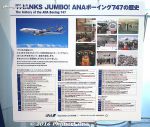
Panel about the 747. ANA retired its last Boeing 747 in March 2014. ANA first flew 747s in 1979. Will be missed.
|
|

In this lecture hall, ANA's tour started with a 30-min. talk and video about flight, their planes, Haneda Airport, etc.Part of ANA's talk was about how planes fly. They demonstrated how wind can lift the wings of a toy plane.
|
|

ANA's lecture hall has some exhibits like model planes.
|
|

ANA's whale plane.
|
|

ANA's Peanuts (Charlie Brown) plane.
|
|

Tire, cockpit window, lights.
|
|

Free souvenir of the tour. Cell phone strap with an ANA maintenance man.
|
|
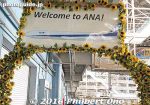
After the slide show lecture, we wore a hard hat and walked on the overpass to the plane hangars. There were around 80 people in the tour and they divided us into around 15 people per group for the hangar tour. Each group had a guide explaining things in Japanese.
|
|

ANA's airplane maintenance hangar at Haneda Airport. Photography was permitted, but no videos. You can post photos online, but you need their approval. These photos here have been approved by ANA. They don't allow ANA personnel and the other tour participants to be pictured. Also cannot show any non-ANA plane.
|
|
|

ANA's Boeing 787
|
|

ANA's Boeing 787 inside the maintenance hangar at Haneda Airport.
|
|

Engine removed from the plane.
|
|

Passenger seats were taken out and the cushions replaced.
|
|
|

Where the tail fits.
|
|

Tires
|
|

Tires
|
|

Tires are not that huge. Tires are inflated with nitrogen, not air (one thing that they always mention).
|
|

They have to replace the tires quite often, every 2 months or so.
|
|
|
|

Extra hangar space.
|
|
|

Jet engine undergoing maintenance.
|
|

Jet engine undergoing maintenance.
|
|
|
|
|

The hangar can get very noisy when they are testing an engine.
|
|

ANA plane
|
|

Always impressive to see a jet plane up close. We see it only on the outside, cannot go inside the plane.
|
|
|
|
|
|
|
|

ANA plane parked outside the maintenance hangar.
|
|

Extra dock in the maintenance hangar.
|
|
|

Jet engine cowlings.
|
|

How workers get around. Enjoyed the tour.
|
|

Ikegami Baien Garden was originally the estate of Kokura Makoto (小倉誠), an owner of a high-class restaurant. After he died, his family donated the estate to Tokyo which later transferred it to Ota Ward.
|
|
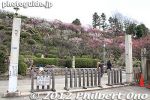
Entrance to Ikegami Baien plum tree garden which opened in Aug. 1978. Admission is only 100 yen. The garden is operated by Ota Ward.
|
|
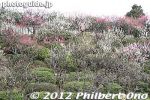
Excellent sloping garden boasting over 360 plum blossom trees amid numerous azalea bushes. Near Nishi-Magome Station on the Toei Asakusa Line.
|
|
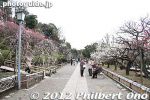
The garden is open from 9 am to 4:30 pm (enter by 4 pm). Closed on Mon. except in Feb. and March.
|
|
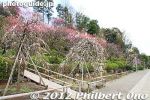
Most of the plum trees are on this hillside on the left. More trees if you walk further straight.
|
|
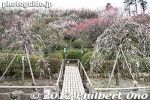
Ikegami Baien Garden in Ota Ward, Tokyo.
|
|
|
|
|
|
|
|
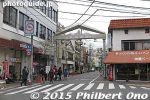
In front of Ikegami Station on the Tokyu Ikegami Line, follow this road for a short walk to Ikegami Honmonji temple.
|
|

Way to Ikegami Honmonji Temple. Belonging to the Nichiren Sect, this is one of Tokyo's major temples.
|
|
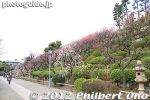
Ikegami Baien Garden, Ota Ward, Tokyo
|
|
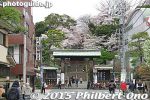
Somon Gate, the first gate you pass through to enter the temple and one of the few structures which were not destroyed during World War II. 総門
|
|
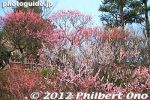
Plum blossoms at Ikegami Baien Garden, Ota Ward, Tokyo
|
|
|
|
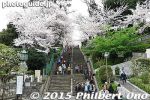
Stone steps to the temple amid cherry blossoms. 此経難持坂
|
|
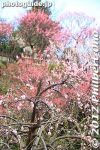
Plum blossoms at Ikegami Baien Garden, Ota Ward, Tokyo
|
|
|
|
|
|
|
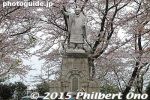
Statue of Nichiren 日蓮聖人像
|
|
|
|
|
|
|
|
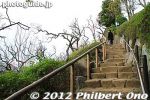
There are steps to go up the slope of plum trees.
|
|
|
|
|

Map of temple grounds. There are both traditional and modern buildings.
|
|
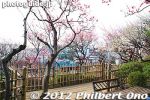
Small lookout deck at the top of the hillside of plum trees.
|
|

Niomon Gate 仁王門(三門)
|
|
|

Soshido Main Hall, Ikegami Honmonji. The original Main Hall was burned during an bombing raid in April 1945. 大堂(祖師堂)
|
|
|

The hall was reconstructed in 1964 financed by donations from all over Japan. It is a ferro-concrete structure. 大堂(祖師堂)
|
|
|

Incense burner
|
|
|
|
|
|
|
|

The plum blossom is Ota Ward's official flower.
|
|

The varieties of plum blossoms at Ikegami Baien Garden.
|
|
|
|
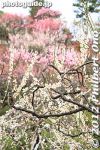
Plum blossoms at Ikegami Baien, Tokyo
|
|
|
|
|
|
|
|
|
|
|
|
|
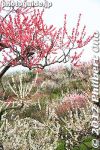
Ikegami Baien Garden plum blossoms in Ota, Tokyo.
|
|
|
|
|
|
|
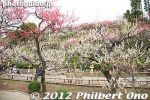
Ikegami Baien Plum Garden in Tokyo.
|
|
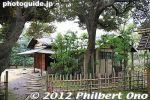
Japanese tea ceremony house for rent. 聴雨庵
|
|
|
|
|
|
|
|
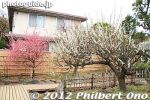
Walk further into the garden to see a few more plum trees.
|
|
|
|
|
|
|
|
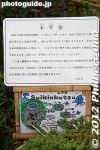
About the Suikinkutsu, a water drop harp.
|
|
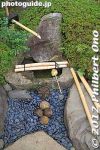
Called a Suikinkutsu, the water drops make a soothing sound like from a koto harp.
|
|
|
|
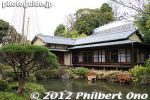
Japanese tea ceremony house and Japanese-style room for rent. 清月庵
|
|
|
|
|
|
|
|
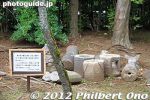
Remains of a torii that collapsed during the March 11, 2011 earthquake.
|
|
|
|
|
|
|
|

大堂(祖師堂)
|
|

Inside Soshido Hall, view of left side. 大堂(祖師堂)
|
|

Inside Soshido Hall, view of right side. 大堂(祖師堂)
|
|

Soshido Hall altar 大堂(祖師堂)
|
|

Hanamatsuri, Buddha's birthday on April 8. A small statue of the baby Buddha is in a miniature temple called Hanami-do (花御堂). This is Ikegami Honmonji temple in Tokyo.
|
|

Hanamatsuri, Buddha's birthday. When the Buddha was born, he walked seven steps and said, "I am my own Lord through Heaven and Earth," and pointed one hand to Heaven and the other to Earth.
|
|

See the baby buddha's hands pointing to Heaven. Sweet tea is poured over a statue of a baby buddha. According to legend, sweet rain (or perfumed water) fell when the Buddha was born.
|
|

People line up to pour sweet tea over the baby buddha. 大堂
|
|

Side view of Soshido Hall. 大堂
|
|

Roof of Soshido Main Hall 大堂
|
|

Doors of Soshido Main Hall 大堂
|
|

Back of Soshido Main Hall
|
|

Five-story Pagoda and cherry blossoms. 五重塔
|
|

Five-story Pagoda was another structure which escaped war damage. 五重塔
|
|

Five-story Pagoda built in 1607, Tokyo's oldest pagoda. 五重塔
|
|

五重塔
|
|
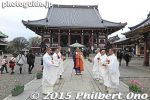
A spring ceremony is held in early April.
|
|
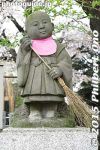
Boy priest sweeping at Ikegami Honmonji, Tokyo.
|
|
|
|
|
|
|
|
|
|
|
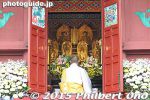
Prayers inside the pagoda.
|
|
|
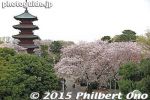
Ikegami Honmonji, Tokyo
|
|

Sign pointing the way to wrestler Rikidozan's grave.
|
|

Rikidozan's grave, the temple's most famous grave.
|
|

Rikidozan's grave
|
|

Rikidozan's gravestone
|
|

Statue of Rikidozan who was famous for his "karate chop" during the 1950s and early '60s. This famous postwar "Japanese hero" was actually Korean.
|
|
|

Statue of Rikidozan (1924-1963) at his grave at Ikegami Honmonji temple, Tokyo. He was a sumo wrestler until 1950 before becoming a pro wrestler.
|
|

Behind the pagoda are many graves.
|
|

Tea ceremony
|
|
|
|
|

Nitchodo Hall 日朝堂
|
|

Bell tower 鐘楼堂
|
|

Treasure House 霊宝殿
|
|

Kyozo houses Buddhist scriptures. 経蔵
|
|

Altar in Kyozo 経蔵
|
|

Gate to Honden
|
|

Honden and temple office on right. 本殿、客殿寺務所
|
|

Honden Hall 本殿
|
|

Hoto tower 宝塔
|
|

Hoto tower built on the site where Nichiren was cremated. 宝塔
|
|

Hoto means "Treasure Tower." A beautiful building. Ikegami Honmonji, Tokyo 宝塔
|
|

Built in 1828 and made of wood. It is the only tower of its kind in Japan placed outdoors. 宝塔
|
|
|
|